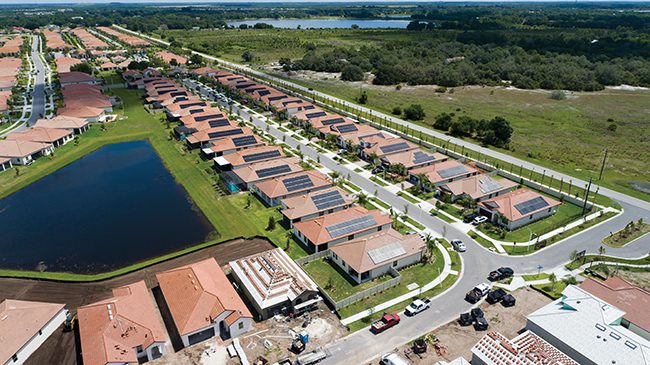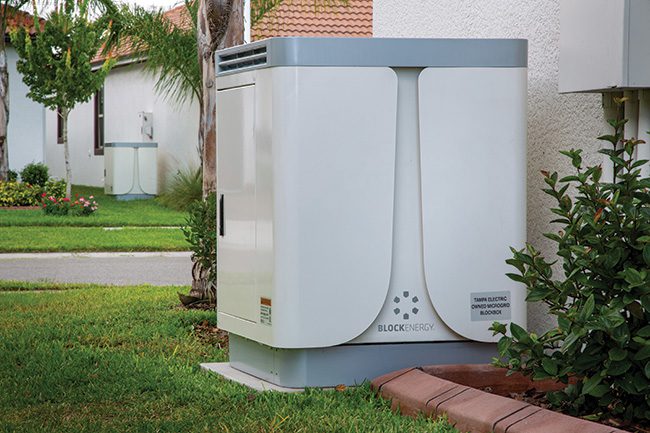Power to the People: Microgrid Gives Community Control of Its Energy
 |
A residential development in Florida provides a model for the future of grid modernization, showcasing reliability and resiliency.
Community microgrids provide a new approach to the design and operation of the power grid at the community level. These microgrids, serving a specific area and supported by renewable energy and other distributed energy resources (DERs), help achieve a sustainable, secure, and cost-effective energy system.
The installations, which can include energy storage among their DERs, can provide indefinite, always-on power. That’s of particular importance in areas prone to extreme weather events. More communities are deriving the economic advantages of such installations, along with environmental benefits in addition to a more reliable and resilient supply of electricity.
A BlockEnergy installation in Florida, approved as a pilot project by the Florida Public Service Commission, is an example of a community microgrid that already has proved its worth. Tampa-based BlockEnergy, considered among the world’s first utility-owned, residential community microgrid developers, in 2022 partnered with home-builder Lennar and Tampa-based Metro Development Group to launch a 37-home microgrid community within the Medley at Southshore Bay residential development in Wimauma, Florida, south of Tampa.
 |
|
1. Homes in the Medley at Southshore Bay development in Florida each have a BlockEnergy BlockBox outside. An upgraded version of the equipment, available next year, will feature an electric vehicle–charging component. Courtesy: BlockEnergy |
BlockEnergy’s communities, with residences known as BlockHomes, have power systems that are networked and work together in support of the community. Each home has a BlockEnergy BlockBox (Figure 1), which sits beside the home and is custom color-matched to the main, exterior wall so it sits naturally within the residential neighborhood.
Each home has power generation and battery energy storage that supplements electricity from the local grid. The system is scalable and, importantly, storm-resilient. That was proven last year when Hurricane Ian pummeled Florida, leaving more than 2.2 million power customers without electricity. The BlockEnergy homes at Medley at Southshore Bay, though, never lost power. The innovation of BlockEnergy’s system, and its proven performance in the face of a natural disaster, makes the Medley at Southshore Bay project the worthy recipient of POWER’s 2023 Distributed Energy Award.
Benefits Beyond the Grid
BlockEnergy said its community microgrid brings several benefits that are not available through traditional grid service. Those include security, energy surety, and resiliency, in addition to access to renewable energy from rooftop solar and battery energy storage.
“BlockEnergy is the only residential utility-owned, always-on microgrid platform available on the market now,” said Rob Bennett, founder and CEO of BlockEnergy. “U.S. utilities are purchasing our BlockEnergy system. We’re grateful to work with utilities, like Tampa Electric [TECO] and Potomac Electric [in Washington, D.C.], who are committed to providing cost-effective, clean energy solutions to their customers and advancing net-zero carbon goals. There’s no investment cost for homeowners or additional service contracts for them to manage.”
Power is generated and distributed locally with multiple levels of security in the BlockEnergy system, which includes protection from cyber and other threats. In the event of an outage, there is no action required of the system as it is “always-on” and not dependent on the grid for ongoing power reliability. That provides resiliency, as there is no single point of failure—each BlockHome has its own solar generation, energy storage, and controls.
“At BlockEnergy, our residential microgrid systems are designed for utility-grade ownership and operation. The system is utility-controlled and can operate as an independent power platform and integrates seamlessly with the grid to offer grid-edge support to our aging grid,” said Bennett. “The building blocks of BlockEnergy’s modular microgrid enable it to scale easily as the community grows.”
Bennett told POWER, “The BlockEnergy residential microgrid system and utility-focused partnership does not currently exist in any other system as most microgrid systems are designed as AC [alternating current]–grid backup power systems. The BlockEnergy system is ‘always on’ because it’s designed using direct current [DC] and is designed for on-peak usage—so it’s never a burden to the grid. It’s an independent power producing neighborhood that’s grid-tied for grid-edge service and support.”
The system also utilizes operational visualization. The BlockEnergy user interface provides second-by-second visual information, enabling operators if necessary to override the system automation and control the amount of energy directed to each load.
The system also has watt-by-watt data, which allows real-time observation and control. The company said the system is autonomous and self-healing, as any problems can be corrected instantly, allowing for quick response and continual optimization.
Weathering the Storm
A consistent supply of energy kept the lights on throughout Medley at Southshore Bay during Hurricane Ian in September 2022. The microgrid system utilized in-neighborhood generation of electricity, storing energy in a network of batteries throughout the community. TECO maintained the rooftop-mounted solar panels, battery storage, and bidirectional tie to the main power grid during the storm.
None of the microgrid equipment was damaged by the hurricane. The system provided 100% uptime to customers, even when the grid-tie went down for three days.
“The BlockEnergy power system operates the entire community networked with central controls, supplemented generation, and extra battery power—making the system scalable and storm-resilient, but not as a backup power system only,” said Bennett. “With no single point of failure, power is generated and distributed locally with multiple levels of security, including protection from cyber and storms. In the event of a grid-tie outage, there is no action required of the system as its ‘always-on’ and not dependent on the grid for ongoing power reliability and resiliency. The grid-tie is for grid services, not for grid-dependency.”
Bennett noted the importance of delivering grid services without being dependent on the local grid. “Yes, BlockEnergy functions autonomously. At its essence, the BlockEnergy system is comprised of microgrids and nanogrids, which enable off-grid energy service and the ability to share excess energy produced back to the grid—making the system much more valuable and reliable than traditional solar-plus-storage,” said Bennett.
Because the system at Medley at Southshore Bay operates under a utility-owned business model, homeowners still pay for electricity at the same metered rate as they normally would, with no extra grid charges or other fees. In the BlockEnergy network, though, as much as 70% of their electricity comes from solar power. Since rooftop solar is included with each home, there is no need for a homeowner to install their own rooftop system or go through the permitting or install process. Homeowners also are not responsible for the upkeep and maintenance of the system.
“The BlockEnergy neighborhood at Medley is integrated seamlessly with the broader utility grid, offering easier management and control of distributed energy,” said Bennett. “[As] a hybrid AC/DC system, the BlockEnergy system readies itself as a futureproof design to allow native-DC loads at the home directly without conversion, making the system much more efficient.
“Usually, clean energy or even backup power comes with a price tag for homeowners to retrofit or plan their resiliency systems,” said Bennett. “But BlockEnergy makes clean energy accessible and affordable. With the utility-owned business model, homeowners still pay for electricity through their utilities, as always.”

Adding EV Charging
Bennett said a Version 3.0 BlockBox system will be available to homeowners in 2024. The new BlockBox will be equipped with an integrated DC electric vehicle (EV) charger.
“Some homeowners believe their home has a higher resale value due to the resilient energy system they adopted with BlockEnergy,” said Bennett, noting the growth of such community microgrids across the U.S., including government or utility-sponsored programs in states including New Jersey, California, and Maryland.
“BlockEnergy provides a system to utilities and doesn’t bill homeowners—this is the responsibility of the utility,” said Bennett. “In the case of Medley, by partnering with utilities for the front-of-the-meter model, the superior energy system had no direct investment cost required by the homeowner because BlockEnergy has helped TECO make the case that the system is an effective substitution to serving new residential energy loads on the distribution grid.”
BlockEnergy, like other companies participating in the buildout of community microgrids, has said such projects offer a solution to the challenge of modernizing the power grid. It’s a way to help support local utilities as they strive to build more infrastructure for power generation, transmission, and distribution. It also supports the power generation sector’s efforts to decarbonize, replacing fossil fuel–powered electricity production with renewable energy and battery storage.
“In the example of the homeowners at Medley at Southshore Bay, homeowners did not have to pay a higher price for their BlockEnergy-powered home as this was the agreement and decision of TECO [the system owner],” said Bennett. “The homeowners also received countless benefits, one of the biggest being the peace of mind in knowing their energy security and consistency is much higher.”
—Darrell Proctor is a senior associate editor for POWER (@POWERmagazine).